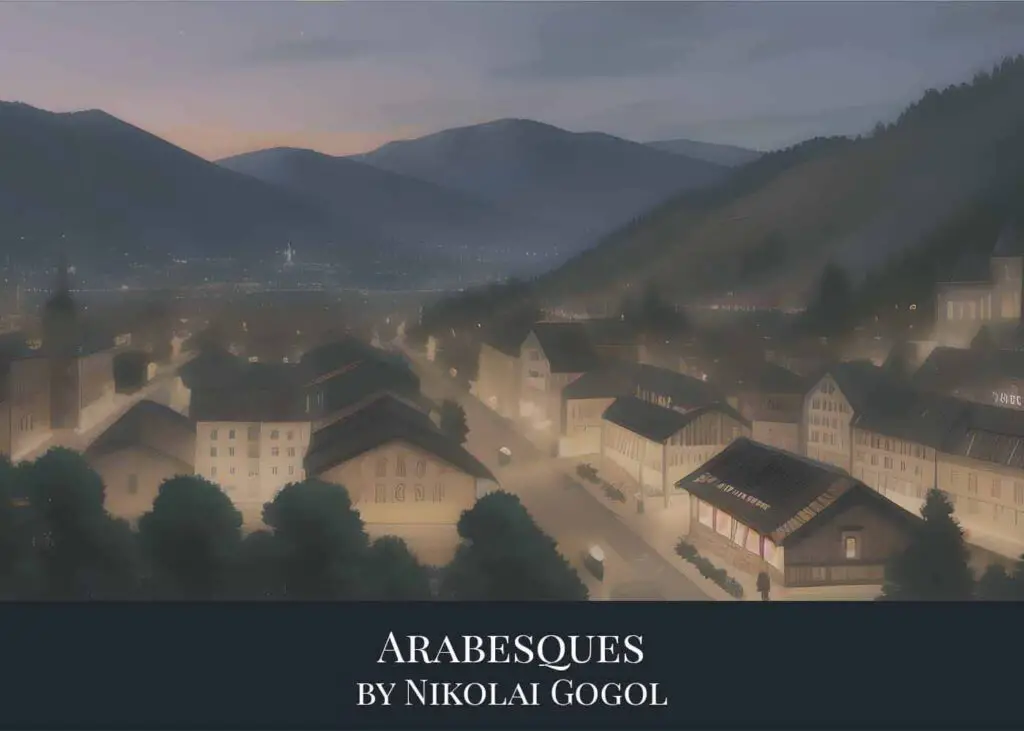
Arabesques by Nikolai Gogol
Author: Nikolai Gogol
Published: 1835
Genre: Short Stories Collection
Arabesques is an anthology by Nikolai Gogol, which was published in 1835. The anthology includes short stories and articles that share his perspective on art and literature.
1. Arabesques Synopsis
Arabesques refer to an Arabic style of design that comprises winding lines. It symbolizes the direction of the anthology, where Gogol’s thoughts and opinions on various topics are collated and come together to form a larger narrative.
2. Arabesques Summary
Some key works in Arabesques are “The Mysterious Portrait,” “A Chapter from an Historical Novel,” “Nevsky Prospekt,” “The Prisoner,” and “Diary of a Madman.” For the articles in the anthology, we are given a glimpse of Gogol’s profound worldview on art and literature, from famous Russian poets to renowned paintings.
Gogol is known for his absurdist yet romantic writing style, and through his discussion of art and literature, like the winding lines that the title references, we see Gogol’s opinions wind to form the foundation of his cynical, escapist, and romanticized worldview.
2.1. The Mysterious Portrait: A Glimpse into the Abyss of Obsession
In “The Mysterious Portrait,” Gogol introduces us to the character of Chartkov, a young man whose life takes a peculiar turn when he becomes infatuated with a portrait of a beautiful woman. This infatuation evolves into an all-consuming obsession that drives Chartkov to the brink of madness.
Gogol’s active voice plunges us into the depths of Chartkov’s obsession. We feel his growing unease and the palpable tension as he descends into madness. Through vivid descriptions and a relentless narrative pace, Gogol masterfully conveys the eerie transformation of an ordinary man into a tormented soul, trapped by the power of art.
Read The Mysterious Portrait at PageVio. A summary of The Mysterious Portrait is available at Sevenov.
2.2. Nevsky Prospect: The Labyrinth of Love and Fate
In “Nevsky Prospect,” Gogol invites readers to stroll along the bustling streets of St. Petersburg, where the lives of two men intersect through the intoxicating allure of a woman. The story revolves around the pursuit of love, the cruelty of fate, and the profound impact of chance encounters. Through the intertwined destinies of the two protagonists, Gogol explores themes of love, longing, and the capricious nature of fate.
As the story unfolds, readers are drawn into a whirlwind of emotions, from the ecstasy of love to the agony of unfulfilled desires. “Nevsky Prospect” stands as a poignant exploration of the human heart and the unpredictable course of life, reminding us that in the bustling cityscape of existence, chance encounters can shape our destinies in unexpected ways.
2.3. Diary of a Madman: The Abyss of Madness
In “Diary of a Madman,” Gogol takes us on a harrowing journey into the fractured mind of the protagonist, Poprishchin. Through the diary entries of this lowly civil servant, we witness his descent into madness, marked by delusions of grandeur and a haunting obsession with the chief clerk’s daughter.
Gogol’s active voice immerses us in the disorienting world of Poprishchin. As his grip on reality slips, the narrative becomes increasingly erratic and hallucinatory. The reader is transported into the depths of madness, experiencing the protagonist’s anguish and paranoia firsthand. The story serves as a chilling commentary on the dehumanizing effects of bureaucracy and societal pressures.
Read Diary of a Madman at PageVio. A summary of Diary of a Madman is available at Sevenov.
3. Conclusion: Arabesques, A Tapestry of Gogol’s Imagination
Nikolai Gogol’s “Arabesques” is a collection that transcends the boundaries of time and genre. Through these five stories, Gogol invites us to explore the intricacies of obsession, historical intrigue, chance encounters, and the depths of madness. His active voice, vivid descriptions, and unparalleled storytelling make each narrative a captivating journey into the human experience.
As we traverse the realms of imagination within “Arabesques,” we are reminded of Gogol’s enduring legacy as a master of Russian literature and a pioneer in exploring the complexities of the human condition.




